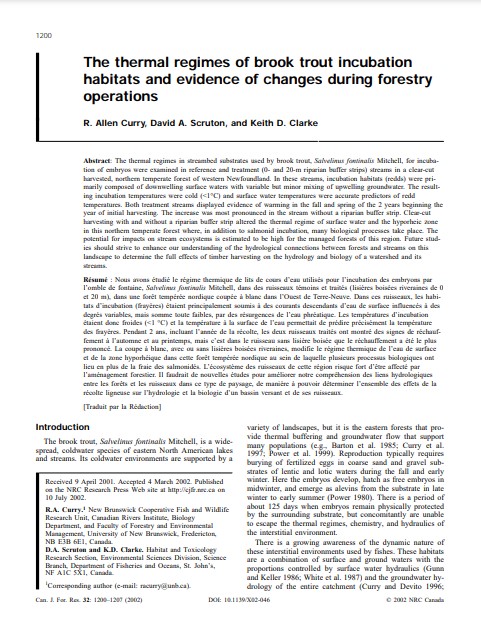The thermal regimes of brook trout incubation habitats and evidence of changes during forestry operations
Bosque Modelo:
Western Newfoundland
Temática:
Conservación
Tipo de documento:
Artículo científico
Resumen
The thermal regimes in streambed substrates used by brook trout, Salvelinus fontinalis Mitchell, for incubation of embryos were examined in reference and treatment (0- and 20-m riparian buffer strips) streams in a clear-cut harvested, northern temperate forest of western Newfoundland. In these streams, incubation habitats (redds) were primarily composed of downwelling surface waters with variable but minor mixing of upwelling groundwater. The resulting incubation temperatures were cold (<1°C) and surface water temperatures were accurate predictors of redd temperatures. Both treatment streams displayed evidence of warming in the fall and spring of the 2 years beginning the year of initial harvesting. The increase was most pronounced in the stream without a riparian buffer strip. Clear-cut harvesting with and without a riparian buffer strip altered the thermal regime of surface water and the hyporheic zone in this northern temperate forest where, in addition to salmonid incubation, many biological processes take place. The potential for impacts on stream ecosystems is estimated to be high for the managed forests of this region. Future studies should strive to enhance our understanding of the hydrological connections between forests and streams on this landscape to determine the full effects of timber harvesting on the hydrology and biology of a watershed and its streams.
Información Bibliográfica
Autor:
Curry, RA, DA Scruton and KD Clarke.
Revista:
Canadian Journal of Forest Research
Año:
2002
N°:
7
País :
Canadá
Páginas:
1200 - 1207
Volumen:
32
Idioma:
Ingles
Palabras claves
northern temperate forest of western Newfoundland





